The carbon emissions from Bitcoin mining in one year amount to 3.4 billion yuan
The author of this article is Digiconomist, compiled by Rhythm 0x49.
Recently, Bitcoin has attracted widespread attention both domestically and internationally regarding energy consumption and carbon emissions. Tesla CEO Elon Musk, who holds over $1 billion, recently stated that Tesla will resume allowing Bitcoin transactions when miners use more than 50% clean energy for mining.
In today's international environment, carbon emissions are extremely important for both Tesla and Bitcoin. In 2020, Tesla's net profit was $721 million, while it earned $1.58 billion solely from selling carbon credits.
Previously, one of the largest cryptocurrency derivatives exchanges, BitMEX, announced that for every $1 fee paid by users, at least $0.0026 will be donated to offset carbon footprints (Note: carbon footprint refers to the "carbon consumption" of an individual or group). The trading platform FTX stated that carbon offsets are not the only solution to the environmental footprint of cryptocurrencies, but it is a good start.
On July 16, China's carbon emissions trading officially launched at the Shanghai Environment and Energy Exchange, with the first matched price at 52.78 yuan per ton, totaling 160,000 tons and a transaction value of 7.9 million yuan. This also marks China's first step into carbon trading.
According to a report released by the United Nations Environment Programme in 2019, global carbon emissions are expected to reach 56 billion tons of CO2 equivalent by 2030, which could lead to a global temperature rise of more than 1.5 °C. If emissions can be reduced to below 25 billion tons equivalent, there is still a chance to limit global warming to within 1.5°C.
Therefore, understanding the carbon emissions generated by Bitcoin mining is extremely important. Of course, new technologies are not all perfect. Just as Bitcoin has a significant impact on the environment, the platform Digiconomist, dedicated to revealing the unintended consequences of the digital transformation wave, recently published an article exploring the sustainability and carbon emissions of Bitcoin.
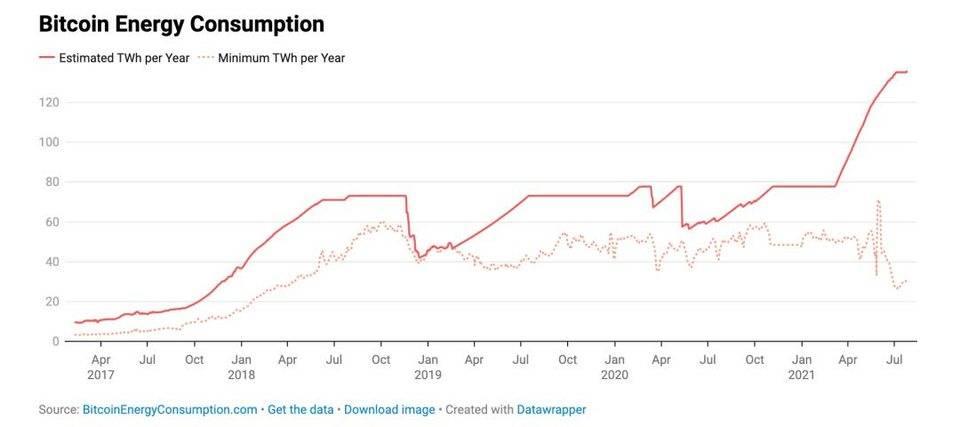 Bitcoin Energy Consumption
Bitcoin Energy Consumption
The minimum energy consumption is calculated based on the total network hash rate of Bitcoin. Data before February 13, 2019, is uniformly calculated using the Antminer S9 with a power consumption of 1500 watts. From February 13, 2019, to November 7, 2019, the Antminer S15 is used for calculations. After November 7, 2019, the Antminer S17e is used, and after October 31, 2020, the Antminer S19 Pro is used for calculations.
 Annual Bitcoin Carbon Footprint
Annual Bitcoin Carbon Footprint
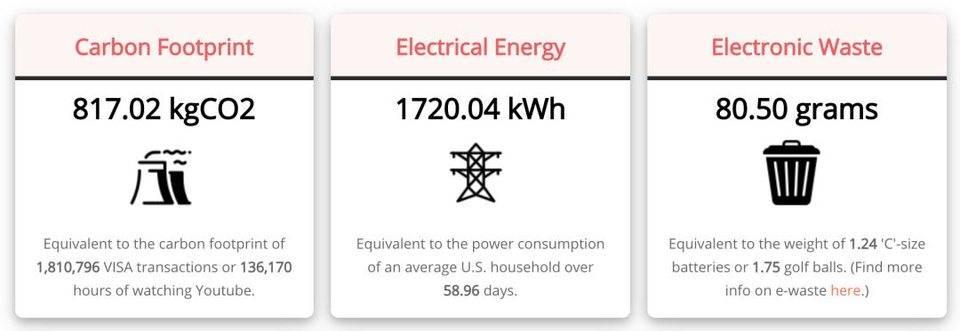 Single Bitcoin Carbon Footprint
Single Bitcoin Carbon Footprint
Currently, the annual total carbon footprint of Bitcoin is 64.44 million tons, equivalent to the carbon footprint of Serbia and Montenegro; the annual total electricity consumption is 135.66 terawatt-hours, equivalent to 135.66 billion kilowatt-hours, which is the same as Sweden's electricity consumption; at the same time, it also produces 6,350 tons of electronic waste. If calculated at the Shanghai Environment and Energy Exchange's price of 52.78 yuan per ton, the annual total carbon footprint of Bitcoin is worth approximately 3.4 billion yuan.
The annual total carbon footprint of a single Bitcoin is 817.02 kilograms, equivalent to 1.81 million transactions using a VISA card or watching 130,000 hours of online videos; the annual total electricity consumption is 1,720 kilowatt-hours, equivalent to the electricity consumption of an average American household for 58 days; at the same time, it also produces 80.5 grams of electronic waste.
I. Discussion on the Sustainability of Bitcoin
As Bitcoin mining continues to provide miners with a stable source of income, miners are willing to purchase mining machines and participate in this game by consuming electricity. This has led to the total hash rate and energy consumption of the Bitcoin network reaching new highs (before the crackdown on mining in Sichuan, Yunnan, and other places). If Bitcoin were a country, its energy consumption would rank 28th globally.
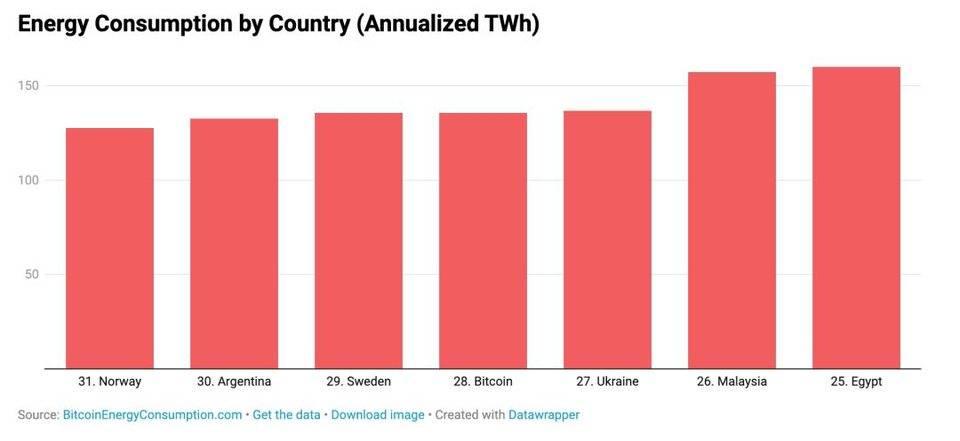
Of course, consuming a large amount of energy may not be Bitcoin's biggest problem. The fact that most mining equipment in the Bitcoin network is located in regions that heavily rely on coal power may be Bitcoin's biggest issue.
II. The Proportion of Clean Energy in Bitcoin Mining Remains Low
In recent years, determining the carbon impact of the Bitcoin network has been a challenge. This is because it is necessary not only to know the electricity consumption of the Bitcoin network but also to know the source of that electricity.
Understanding the power source through the location of Bitcoin miners is one method. Of course, determining the location of Bitcoin miners is not an easy task.
Initially, as everyone knows, Bitcoin miners were mainly located in China, where the average emission factor of the Chinese power grid is 700g CO2/kWh. Using this factor, the carbon intensity of the electricity used for Bitcoin mining can be estimated (carbon intensity refers to the CO2 emissions per unit of GDP). Assuming that 70% of Bitcoin mining occurs in China and that 30% of it uses clean energy, the weighted average carbon intensity would be 490 gCO2eq/kWh.
Later, in a global cryptocurrency benchmarking study conducted by Garrick Hileman and Michel Rauchs in 2017, more detailed information became available. In this study, they confirmed that the lower limit of total energy consumption for devices accounting for about half of the Bitcoin network's hash rate is approximately 232 megawatts. Mining equipment located in China accounts for half of this, with a lower limit of energy consumption of about 111 megawatts.
The energy consumption details of the mining equipment surveyed by Garrick Hileman and Michel Rauchs are shown in the figure below. By corresponding to the carbon emission factors of various countries' power grids, the weighted average carbon intensity of the Bitcoin network is calculated to be 475 gCO2eq/kWh.
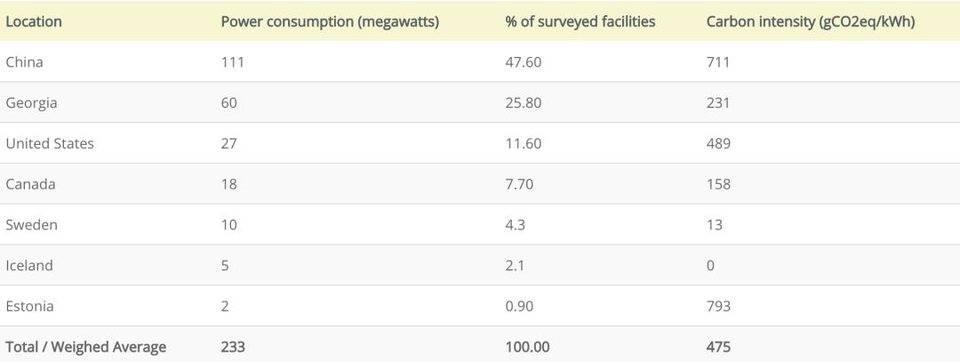
III. 39% of Energy Consumption Comes from Renewable Energy
Some users have indicated that certain regions in some countries may provide energy with lower carbon intensity. In 2018, Coinshares stated that most mining machines in China are located in Sichuan and use cheap hydropower for mining. However, subsequent studies could not support this claim. In light of this situation, the lead author of the Coinshares paper admitted to "making a mistake."
Specifically, while the electricity generation during the rainy season in Sichuan is three times that of the dry season, hydropower is not produced continuously. The fluctuations in hydropower generation mean that miners can only take advantage of cheap hydropower during limited times.
In a 2019 study on Bitcoin's carbon footprint conducted by Christian Stoll and others, they introduced the method of locating miners based on IP addresses to account for regional differences in calculating the weighted average carbon intensity of the entire Bitcoin network, yielding a value of 480-500, which is close to the previously mentioned 475.
Similarly, using a similar method, Cambridge University provided a map of the changing locations of Bitcoin miners over time in 2020. By filling different colors based on location data and the carbon intensity of different power grids, the proportion of mining activities in various regions during the dry season can be obtained as shown in the figure below. Therefore, on an annual basis, the contribution of renewable energy to the Bitcoin network remains very low. According to an interview by Cambridge University in 2020, miners indicated that about 39% of energy consumption comes from renewable energy.

IV. Who Consumes More Energy: Bitcoin, VISA, or Gold?
To better measure the energy consumption of the Bitcoin network, VISA can be used as a reference. In 2019, VISA processed a total of 138.3 billion transactions. VISA stated that its global operational activities consumed a total of 740,000 terajoules. This means that the energy consumed by VISA is equivalent to the consumption of 19,304 American households. After calculation, the carbon footprint of each VISA transaction is 0.45 gCO2eq.
These data indicate that there is still a significant gap between Bitcoin and VISA, with the energy intensity of each Bitcoin transaction being higher than that of VISA. Moreover, the gap in carbon footprints between the two is even more pronounced.
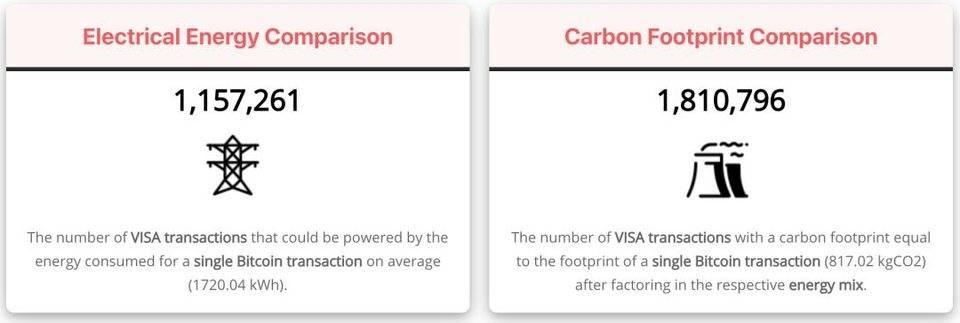
Of course, VISA does not fully represent the global financial system. However, even compared to non-cash transactions in the conventional financial system, Bitcoin transactions require more energy.
From another perspective, if Bitcoin is viewed as "digital gold," then a comparison can be made between Bitcoin mining and gold mining. Currently, approximately 3,531 tons of gold are mined each year, emitting about 81 million tons of CO2. However, this type of comparison has certain flaws, as gold mining can be paused while Bitcoin mining cannot.

V. Limited Scalability Leads to Extreme Carbon Footprint
The main reason for the exaggerated carbon emissions generated by each Bitcoin transaction is that the underlying blockchain is not only built on energy-consuming algorithms but also has extremely limited transaction processing capacity. In an optimistic scenario, Bitcoin can process about 220 million transactions per year.
In contrast, the global financial system processes over 700 billion payments annually, and payment providers like VISA can process over 65,000 transactions per second. Due to the limitations in transaction processing speed, Bitcoin cannot achieve any form of mainstream adoption as a global currency or payment system.
For Bitcoin, the scalability issue also lacks a real solution. Some supporters of digital currencies believe that Layer 2 solutions like the Lightning Network can help scale Bitcoin, but such solutions are clearly contradictory to the impossibility of large-scale transfers. To transfer funds to the Lightning Network, transactions must first occur on the main network.
Based on current network performance, it would take the Bitcoin network 35 years to conduct one transaction for each of the 7.7 billion people on Earth. So far, the only practical way to address Bitcoin's scalability issue is to use trusted third parties for internal transaction processing instead of using the Bitcoin blockchain. However, this is merely reinventing the wheel.
PoW is the first algorithm to prove its success, but it is not the only algorithm. In recent years, more energy-efficient algorithms like PoS have been developing. Compared to PoW, the energy consumed by PoS is negligible. It is estimated that if Bitcoin switched to PoS, it could save 99.95% of energy consumption compared to the current PoW.
Original link: https://digiconomist.net/bitcoin-energy-consumption








